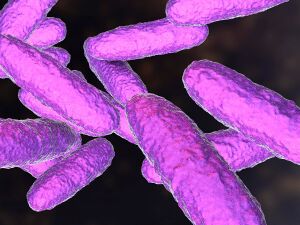Klebsiella granulomatis

Classification
Bacteria; Psuedomonadota; Gammaproteobacteria; Enterobacterales; Enterobacteriaceae
Species
|
NCBI: [https://www.ncbi.nlm.nih.gov/Taxonomy/Browser/wwwtax.cgi?mode=Info&id=1007084&lvl= ] |
Klebsiella, K. granulomatis
Description and Significance
Klebsiella granulomatis is a rod-shaped, gram-negative bacteria that can be found in vacuoles in the cytoplasm and is predominantly pleomorphic, meaning it can be found in a variety of shapes and sizes. It is a cause of genital ulcers and can be found in western countries and is more common in Africa as well as South America (Gottesman, 2014). Since it is the cause of genital ulceration, it is important to study this bacterium to mitigate the human immunodeficiency virus (HIV) epidemic.
Genome Structure
Klebsiella granulomatis measures about 1 to 2 µm by 0.5 to 0.7 µm in size (Ballard, 2015). This bacterium is considered pleomorphic because it can grow in multiple shapes and sizes such as coccoid, diplococci, straight rods, ovoid, or elliptical(Carter,1999).
The total length of the genome ranges from 5.1 to 5.6 Mb and shows genetic variation due to genomic rearrangements and strain-specific genes. In a separate study that was done, K. granulomatis was shown to have a GC content of about 57%. In 1999, based on molecular aspects of genes 16SrRNA and phoE, donovanosis was reclassified as K. granulomatis (Velho, 2008).
Cell Structure, Metabolism and Life Cycle
Klebsiella granulomatis measures about 1 to 2 µm by 0.5 to 0.7 µm in size (Ballard, 2015). It is difficult to study 'K. granulomatis' because it cannot grow in artificial culture media. This micro-organism was noted to have a complex cell envelope comprised of the corrugated cell wall and cytoplasmic membrane (Chandra, 1991). The organism was coated with multiple fimbriae and blebs and the cytoplasm was found to inherit electron-dense polar bodies (Chandra, 1991). K. granulomatis produces large ulcers due to inflamed granulation tissues as well as numerous macrophages (Gupta, 2008). When infected, it takes one to several weeks to see infection within the body but is treatable with antibiotic therapy. There is also a chance of relapse after treatment that can occur in a little over a year.
Ecology and Pathogenesis
K. granulomatis can be found in developing areas such as India, New Guinea, and southern Africa affecting humans and animals. It is most common with people that exhibit poor hygiene and people that have lower socio-economic status. K. granulomatis is often associated with urinary tract infections (UTI) and pneumonia (Martínez, 2004). Common symptoms include fever and chills. K. granulomatis infects the body by eroding through the skin in genital areas and producing lesions/blisters. When infected, it takes one to several weeks to see infection within the body but is treatable with antibiotic therapy. There is also a chance of relapse after treatment that can occur in a little over a year. Due to antibiotic resistance strains occurring in antibiotics used to treat this disease, it can be hard to fully treat infections that are caused by K. granulomatis.
It is important to keep yourself and others informed and to use prevention strategies such as getting tested, practicing safe sex, using less risky sexual behaviors, and more. Since this is a very serious sexually transmitted disease (STD) that is becoming hard to fully treat, learning more about K. granulomatis and its effects is important because it can help mitigate the HIV epidemic and/or prevent STDs.

References
AK;, C. M. J. (n.d.). Fine structure of Calymmatobacterium granulomatis with particular reference to the surface structure. The Indian journal of medical research. Retrieved November 16, 2022, from https://pubmed.ncbi.nlm.nih.gov/1959951/
Ballard, R. C. (2014, October 31). Klebsiella granulomatis (donovanosis, granuloma inguinale). Mandell, Douglas, and Bennett's Principles and Practice of Infectious Diseases (Eighth Edition). Retrieved November 16, 2022, from https://www.sciencedirect.com/science/article/pii/B978145574801300237X
Carter, Jenny S., et al. “Phylogenetic Evidence for Reclassification of Calymmatobacterium Granulomatis as Klebsiella Granulomatis Comb. Nov.” International Journal of Systematic and Evolutionary Microbiology, Microbiology Society, 1 Oct. 1999, https://www.microbiologyresearch.org/content/journal/ijsem/10.1099/00207713-49-4-1695?crawler=true.
DiMaria, Christine. “Granuloma Inguinale and Its Treatments.” Healthline, Healthline Media, 24 Oct. 2018, https://www.healthline.com/health/granuloma-inguinale#diagnosis.
Gottesman, L., & Shehebar, J. A. (2013, June 23). Sexually transmitted diseases and the anorectum. Colorectal Surgery (Fifth Edition). Retrieved November 16, 2022, from https://www.sciencedirect.com/science/article/pii/B9780702049651000160
Gupta, P. K., & McGrath, C. (2009, November 6). Microbiology, inflammation, and viral infections. Comprehensive Cytopathology (Third Edition). Retrieved November 16, 2022, from https://www.sciencedirect.com/science/article/pii/B9781416042082100077
Lee, Bruce Y. “Donovanosis: Why This Is Called a 'Flesh Eating' Sexually Transmitted Infection.” Forbes, Forbes Magazine, 21 Apr. 2022, https://www.forbes.com/sites/brucelee/2021/10/24/donovanosis-why-this-is-called-a-flesh-eating-sexually-transmitted-infection/?sh=38d224a912b4.
Martínez J;Martínez L;Rosenblueth M;Silva J;Martínez-Romero E; (n.d.). How are gene sequence analyses modifying bacterial taxonomy? the case of Klebsiella. International microbiology : the official journal of the Spanish Society for Microbiology. Retrieved November 16, 2022, from https://pubmed.ncbi.nlm.nih.gov/15666246/
U.S. National Library of Medicine. (n.d.). Taxonomy browser (klebsiella granulomatis). National Center for Biotechnology Information. Retrieved November 16, 2022, from https://www.ncbi.nlm.nih.gov/Taxonomy/Browser/wwwtax.cgi?mode=Info&id=39824
Velho, Paulo Eduardo Neves Ferreira, et al. “Donovanosis.” Brazilian Journal of Infectious Diseases, Brazilian Society of Infectious Diseases, 1 Dec. 2008, https://www.scielo.br/j/bjid/a/37tsDqLnww4F9NdvmPDXKdB/?lang=en.
Author
Page authored by Ashley Byrd, student of Prof. Bradley Tolar at UNC Wilmington.
